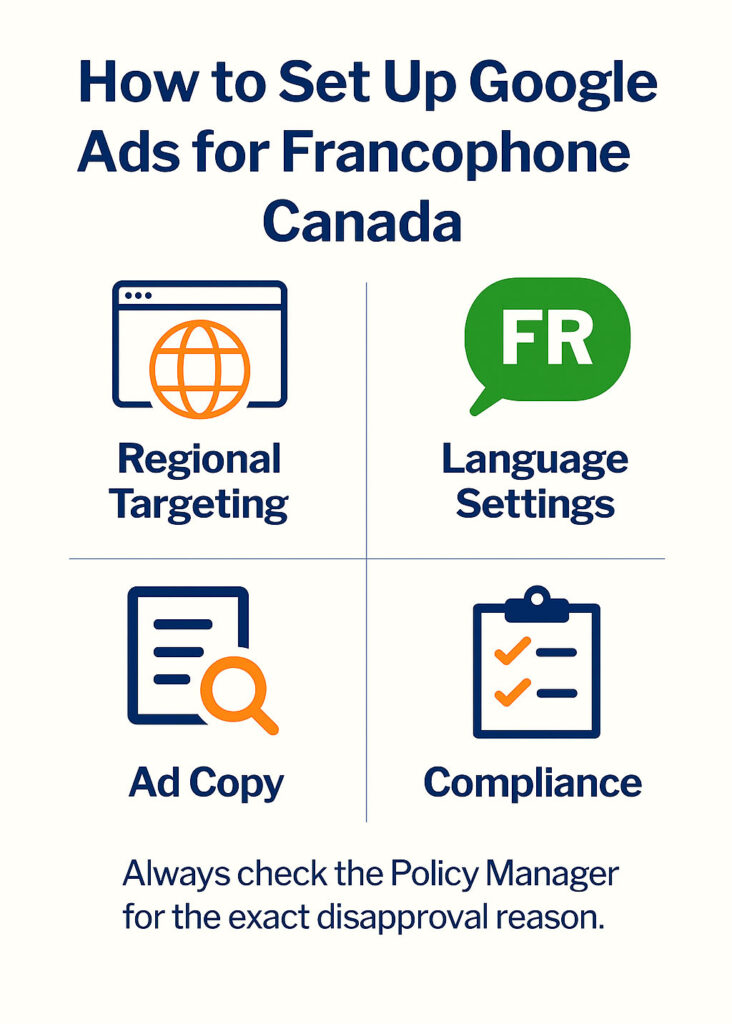Canada is officially bilingual, but the distribution of French speakers is far from uniform. Quebec is home to nearly 85% of the country’s francophone population, while significant communities also exist in parts of Ontario, New Brunswick, and Manitoba.
If you’re advertising in Canada, ignoring French-speaking audiences — especially in Quebec — isn’t just inefficient; it can lead to compliance issues and missed conversions. Quebec’s Charter of the French Language requires that advertising be delivered in French. Simply running English-language campaigns and hoping for the best is not a viable strategy.
Successful Google Ads campaigns for French-speaking users must address three layers: language, location, and cultural context.

Smart Campaign Setup for Francophone Audiences
1. Language Settings: Serve the Right Ad to the Right User
Google Ads doesn’t detect language preference based on geography, but rather based on the user’s browser language or device settings.
Recommendation:
Set your campaign language to “French” if your assets are fully localized. For hybrid approaches, use separate campaigns for “English” and “French” to control messaging and reporting independently.
Avoid combining both in one campaign. You’ll lose clarity in performance data and risk delivering mismatched language experiences.
2. Geographic Targeting: Go Beyond Quebec
The core market is obviously Quebec — but not all of it is uniformly francophone. Metropolitan areas like Montreal are diverse, while others (like Saguenay or Trois-Rivières) are almost entirely French-speaking.
Additional target regions include:
- Ottawa and Eastern Ontario: Significant bilingual population
- New Brunswick: The only officially bilingual province — focus on Moncton, Edmundston, and the Acadian Peninsula
- St. Boniface (Winnipeg, Manitoba): Historical Franco-Manitoban community
- Northern Ontario (e.g., Sudbury, Hearst)
- Franco-Albertans and BC’s Maillardville region: Optional for broader reach
Tip: Use granular city or radius targeting to focus on urban clusters of French speakers where appropriate.
Ad Campaign Structure: Bilingual Is Not a Blended Strategy
Running a “bilingual” campaign doesn’t mean you run one campaign in two languages. It means you operate two parallel campaigns — one in English, one in French — each with tailored assets.
Benefits of separating French campaigns:
- Tailor bids and budget by language
- Track language-specific performance
- Create native ad copy and extensions
- Comply with provincial legal standards
- A/B test messaging that aligns with local culture
Each campaign should be treated as distinct in tone, wording, and behavior expectations.
Writing French Ad Copy That Works in Quebec
Don’t Just Translate — Localize
Google Translate will not cut it. Quebec French includes unique phrases, formal tones, and consumer expectations that differ from both European French and English Canadian advertising.
Examples of poor vs. better French ad writing:
| Direct Translation | Localized French Copy |
|---|---|
| “Créez votre compte gratuitement” | “Ouvrez votre compte sans frais” |
| “Commandez maintenant!” | “Passez votre commande aujourd’hui” |
Work with native speakers or experienced French copywriters. Your ads should sound natural — not foreign.

Editorial and Legal Guidelines in Quebec (OQLF)
If you advertise in Quebec, you must follow the Office québécois de la langue française (OQLF) requirements. These include:
- Ad copy must be in French (even for international brands)
- French must be as prominent as English in bilingual executions
- Product or service names in English must be accompanied by French descriptors
Failing to follow these guidelines can result in warnings, takedowns, or fines.
CTA and Extension Best Practices
Recommended French CTAs:
- Obtenez votre soumission gratuite (Get your free quote)
- Essayez maintenant (Try now)
- Créez votre compte (Create your account)
- Livraison sans frais (Free shipping)
Use French in all extensions: sitelinks, callouts, call extensions, and structured snippets. Ensure phone support matches the ad language, or include a note if not.
Landing Pages: The Weakest Link in Francophone Campaigns
A common error is targeting French speakers with French ads that lead to English pages. This disconnect damages user trust and drives high bounce rates — and in Quebec, can also violate compliance rules.
Checklist for a high-performing French landing page:
- Fully translated copy — not partial
- Matching CTA and offer (e.g., ad says “Créez votre compte,” button says “Créer mon compte”)
- Localized currency and delivery terms
- French contact forms and support options
- Hosting on a French subdomain or clearly flagged as “français”
Tracking, Reporting & Optimization
To optimize properly, you need clarity at the language and location level. Recommended tactics:
- Segment campaigns by region (e.g., Quebec, Ottawa, Moncton)
- Monitor performance by language and city
- Use GA4 and Google Ads filters to track audience language settings
- Attribute leads by province when using CRM or call tracking
A/B test tone, CTAs, or even regional idioms to refine conversion rates.
Work With 3MY: Multilingual Google Ads Campaigns That Convert
At 3MY, we don’t just translate — we localize for performance. We help clients:
- Structure separate French and English campaigns
- Comply with Quebec’s language regulations
- Write culturally appropriate ad copy for Quebec and francophone markets
- Build landing pages that engage and convert across both languages
- Run bilingual campaigns across Google Search, Display, YouTube, and Performance Max
Want to engage Canada’s French-speaking audiences with campaigns that actually resonate?
[Book a Free Strategy Call →]









